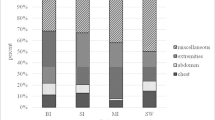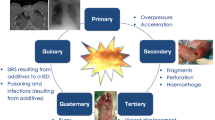Abstract
Introduction
Terror attacks with explosive devices or mass shootings have introduced a new pattern of injuries into the civilian sector. The aim of this short review on the treatment principles for so-called penetrating war wounds is to remind surgeons who are not normally confronted with them of some basic rules to follow and pitfalls to avoid.
Materials and methods
This review article is based on literature research of the National Library of Medicine and the National Institutes of Health MEDLINE database using PubMed, as well as updated books on war surgery and the author’s own experience of war zones.
Results and discussion
Principles of treatment of penetrating war injuries to the head, neck, and torso are all based on damage control surgery focusing on hemorrhage and contamination control and early restoration of the deranged physiology. For injuries to the extremities, differences in treatment principles between low- and high-energy wounds are more important, although initial treatment is also focused on hemorrhage control. The surgical treatment should be based on thorough wound examination and debridement as well as fracture stabilization when required.
Conclusion
Certain knowledge of the treatment of war wounds is necessary in all civilian hospitals that receive patients injured in terror attacks.
Similar content being viewed by others
References
Turégano-Fuentes F, Caba-Doussoux P, Jover-Navalón JM, Martín-Pérez E, Férnandez-Luengas D, Díez-Valladares L, Pérez-Díaz D, Yuste-García P, Guadalajara Labajo H, Ríos-Blanco R, Hernado-Trancho F, García-Moreno Nisa F, Sanz-Sánchez M, García-Fuentes C, Martínez-Virto A, Léon-Baltazar JL, Vazquez-Estévez J. Injury pattern from major urban terrorist bombings in trains: the Madrid experience. World J Surg. 2008;32:1168–75.
Gaarder C, Jorgensen J, Kolstadbraaten KM, Isaksen KS, Skattum J, Rimstad R, Gundem T, Holtan A, Walloe A, Pilgrim-Larsen J, Naess PA. The twin terrorist attacks in Norway on July 22, 2011: the trauma center response. J Trauma Acute Care Surg. 2012;99:59–65.
Paydar S, Sharifian M, Pravaz SB, Abbasi HR, Moradian MJ, Roosbeh J, Nikghbalian S, Sagbheb MM, Ghaffarpasand F, Salehi O, Dehghani J. Explosive attack: lessons learned in the Sayed Al Shohada mosque attack, April 2008, Shiraz, Iran. J Emerg Trauma Shock. 2012;5:296–8.
Teague DC. Mass casualties in the Oklahoma City bombing. Clin Orthop Relat Res. 2004;422:77–81.
Nessen SS, Lounsbury DE, Hetz SP. War surgery in Afghanistan and Iraq: a series of cases, 2003–2007. Washington, DC: United States Army and Borden Institute; 2008.
Giannou C, Baldan M, Molde A. War surgery: working with limited resources in armed conflict and other situations of violence, vol 2. Geneva: The International Committee of the Red Cross (ICRC); 2013.
Husum H, Ang SC, Fosse E. Fasciotomy, debridement and drainage. In: War surgery, field manual. 2nd ed. Penang: Third World Network; 2011.
Coupland RM. The Red Cross wound classification. Geneva: International Committee of the Red Cross; 1991.
Luria S, Rivkin G, Avitzour M, Liebergall M, Mintz Y, Mosheiff R. Comparative outcome of bomb explosion injuries versus high powered gunshot injuries of the upper extremity in a civilian setting. IMAJ. 2012;15:148–52.
Aylwin CJ, König TC, Brennan NW, Shirley PJ, Davies G, Walsh MS, Brohi K. Reduction in critical mortality in urban mass casualty incidents: analysis of triage, surge and resources after the London bombings on July 7, 2005. Lancet. 2006;368:2219–25.
Schwartz D, Pinkert M, Leiba A, Oren M, Haspel J, Levi Y, Goldberg A, Bar-Dayan Y. Significance of a level-2, “selective, secondary evacuation” hospital during a peripheral town terrorist attack. Prehosp Disaster Med. 2007;22:59–66.
C-TECC. Tactical emergency casualty care guidelines. http://c-tecc.org/tactical-emergency-casualty-care-guidelines.
American College of Surgeons Committee on Trauma. Advanced trauma life support for doctors, ATLS student course manual. Chicago: American College of Surgeons; 2008.
Stein M, Hirschberg A. Medical consequences of terrorism. The conventional weapon threat. Surg Clin North Am. 1999;79:1537–51.
Aldrich EF, Eisenberg HM, Saydjari C, Foulkes MA, Jane JA, Marshall LF, Young H, Marmarou A. Prediction of mortality in severely head-injured patients with civilian gunshot wounds: a report from the NIH Traumatic Coma Data Bank. Surg Neurol. 1992;38:418–23.
Lin DJ, Lam FC, Siracuse JJ, Thomas A, Kasper EM. “Time is brain” the Gifford factor—or: why do some civilian gunshots to the head do unexpectedly well? A case series with outcomes analysis and a management guide. Surg Neurol Int. 2012;3:98.
Thach AB, Ward TP, Dick JSB II, Bauman WC, Madigan WP, Goff MJ, Thordsen JE. Intraocular foreign body injuries during Operation Iraqi Freedom. Ophthalmology. 2005;112:1829–33.
Peled M, Leiser Y, Emodi O, Krausz A. Treatment protocol for high velocity/high energy gunshot injuries to the face. Craniomaxillofac Trauma Reconstr. 2012;5:31–40.
Denny AD, Sanger JR, Matloub HS, Yousif NJ. Self-inflicted midline facial gunshot wounds: the case for a combined craniofacial and micro-vascular team approach. Ann Plast Surg. 1992;29:564–70.
Boffard KD. Manual of definitive surgical trauma care. 3rd ed. London: Hodder Arnold; 2011.
Bala M, Shussman N, Rivkind IA, Izhar U, Almogy G. The pattern of thoracic trauma after suicide terrorist bombing attacks. J Trauma. 2010;69:1022–9.
Wu JT, Mattox KL, Wall MJ Jr. Esophageal perforations: new perspectives and treatment paradigms. J Trauma. 2007;63:1173–84.
Bala M, Rivkind AL, Zamir G, Hadar T, Gertsenshtein I, Mintz Y, Pikarsky AJ, Amar D, Shussman N, Abu Gazala M, Almogy G. Abdominal trauma after terrorist bombing attacks exhibits a unique pattern of injury. Ann Surg. 2008;248:303–9.
Goettler CE, Rotondo MF, Giannoudis PV. The damage control approach. In: Pape H-C, Peitzman AB, Schwab CW, Giannoudis PV, editors. Damage control management in the polytrauma patient. Berlin: Springer; 2010.
Ascensio JA, McDuffie L, Petrone P, Roldan G, Forno W, Gambaro E, Salim A, Rowe V, Demetriades D, Murray J, Velmahos G, Shoemaker W, Berne TV, Ramicone E, Chan L. Reliable variables in the exsanguinated patient which indicate damage control and predict outcome. Am J Surg. 2001;182:742–65.
Moore EE, Thomas G. Orr Memorial Lecture. Staged laparotomy for the hypothermia, acidosis and coagulopathy syndrome. Am J Surg. 1996;172:405–10.
Velmahos GC, Constantinou C, Tillou A, Brown CV, Salim A, Demetriades D. Abdominal computed tomography scan for patients with gunshot wounds to the abdomen, selected for non operative treatment. J Trauma. 2005;59:1155–60.
Stone H, Fabian TC. Management of perforating colon trauma: randomization between primary closure and exteriorization. Ann Surg. 1979;1990:430–6.
Demetriades D, Rabinowitz B, Sofianos C, Prümm E. The management of colon injuries by primary repair or colostomy. Br J Surg. 1985;72:881–3.
Murray JA, Demetriades D, Colson M, Song Z, Velmahos G, Cornwell E, Ascension JA, Belzberg H, Berne TV. Colonic resection in trauma: colostomy versus anastomosis. J Trauma Injury Infect Crit Care. 1999;46:250–4.
Ordonez CA, Pino LF, Badiel M, Sánchez AI, Loaiza J, Ballestes L, Puyana JC. Safety of performing a delayed anastomosis during damage control laparotomy in patients with destructive colon injuries. J Trauma. 2011;71:1512–8.
Steele SR, Wolcott KE, Mullenix PS, Martin MJ, Sebesta JA, Azarov KS, Beekley AC. Colon and rectal injuries during Operation Iraqi Freedom: are there any changing trends in management or outcome? Dis Colon Rectum. 2007;50:870–7.
Bartlett CS, Helfet DL, Hausman MR, Strauss E. Ballistics and gunshot wounds: effect on musculoskeletal tissues. J Am Acad Orthop Surg. 2000;8:21–36.
Ordog GJ, Wassserberger JS, Balasubramanium S. Civilian gunshot wounds: outpatient management. J Trauma. 1994;36:106–11.
Mannion SJ, Chaloner E. Principles of war surgery. BMJ. 2005;330:1498–500.
Bowyer GW. Management of small fragment wounds: experience from the Afghan border. J Trauma. 1996;40:S170–2.
Schrager JJ, Branson RD, Johannigman JA. Lessons from the tip of the spear: medical advancements from Iraq to Afghanistan. Respir Care. 2012;57:1305–13.
Kragh JF, Littrel ML, Jones JA, Walters TJ, Baer GC, Wade CE, Holcomb JB. Battle casualty survival with emergency tourniquet use to stop bleeding. J Emerg Med. 2011;41:590–7.
Gifford SM, Aidinian G, Clouse WD, Fox CJ, Porras CA, Jones T, Zarazabel LA, Michalek JE, Propper BW, Burkhardt GE, Rasmussen TE. Effect of temporary shunting on extremity vascular injury: an outcome analysis from the Global War on Terror Vascular Injury Initiative. J Vasc Surg. 2009;50:549–56.
Ramasamy A, Harrison SE, Stewart MPM, Midwinter M. Penetrating missile injuries during the Iraqi insurgency. Ann R Coll Surg Engl. 2009;91:551–8.
Jawas A, Abbas AK, Nazzai M, Albader M, Abu-Zidan FM. Management of war-related vascular injuries: experience from Second Gulf War. World J Emerg Surg. 2013;8:22.
Yelon JA, Scalea TM. Venous injuries of the lower extremities and pelvis: repair versus ligation. J Trauma. 1992;33:532–6.
Murray CK, Hsu JR, Solomkim JS, Keeling JJ, Andersen RC, Ficke JR, Calhoun JH. Prevention and management of infections associated with combat-related extremity injuries. J Trauma. 2008;64:S239–51.
Leininger BE, Rasmussen TE, Smith DL, Jenkins DH, Coppola C. Experience with wound VAC and delayed primary closure of contaminated soft tissue injuries in Iraq. J Trauma. 2006;61:1207–12011.
Ferrière F. Intérêt de la procalcitonine, nouveau marqueur de l’infection bactérienne. Ann Biol Clin. 2000;58:49–59.
Wetterslev M, Rose-Larsen K, Hansen-Schwartz J, Steen-Andersen J, Møller-Sørensen H. Mechanism of injury and microbiological flora of the geographical locations are essential for the prognosis in soldiers with serious warfare injuries. Dan Med J. 2013;60:4707.
Murray CK, Obremskey WT, Hsu JR, Andersen RC, Calhoun JH, Clasper JC, Whitman TJ, Curry TK, Fleming ME, Wenke JC, Ficke JR. Prevention of infections associated with combat-related extremity injuries. J Trauma. 2011;71:S235–57.
Conflict of interest
L. Riddez declares that this manuscript has not been published previously and is not under consideration elsewhere. L. Riddez certifies that there is no conflict of interest.
Compliance with Ethics Guidelines
This article does not contain any studies with human or animal subjects performed by any of the authors.
Author information
Authors and Affiliations
Corresponding author
Rights and permissions
About this article
Cite this article
Riddez, L. Wounds of war in the civilian sector: principles of treatment and pitfalls to avoid. Eur J Trauma Emerg Surg 40, 461–468 (2014). https://doi.org/10.1007/s00068-014-0395-6
Received:
Accepted:
Published:
Issue Date:
DOI: https://doi.org/10.1007/s00068-014-0395-6




